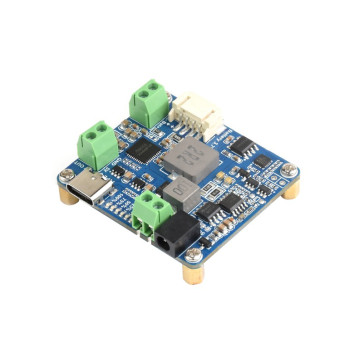Solar Power Manager Module (D) with battery holder
Solar Power Manager Module (D), Supports 6V~24V Solar Panel and Type-C Power Adapter, 5V/3A Regulated Output
Verfügbarkeit: Zur Zeit nicht an Lager
Solar Power Management Module (D)
Recharged From 6V~24V Solar Panel, Or Type-C Power Adapter
5V/3A Regulated Output
Features At A Glance
The Solar Power Management Module (D) is designed for 6V~24V solar panel, it can charge the 3.7V rechargeable Li battery through solar panel or Type-C connector, and provides 5V/3A regulated output (supports multiple protocols such as PD/QC/FCP/PE/SFCP). The module features MPPT (Maximum Power Point Tracking) function and multi protection circuits, therefore, it is able to keep working with high-efficiency, stability, and safety. It is suited for solar-powered, low-power IoT, and other environmental protection projects.
- Supports MPPT (Maximum Power Point Tracking) function, maximizing the efficiency of the solar panel
- Supports solar panel / Type-C power adapter for battery charging
- For 6V~24V solar panel, supports self-adaptive input voltage via DC-002 jack or screw terminal, with input anti-reverse protection
- Multi LED indicators, for monitoring the status of solar panel and batteries
- Multi protection circuits: over-charge / over-discharge / overheat / over-current, stable and safe to use
Version
Single module + Battery holder
Specification Comparison
| SOLAR POWER MANAGER | SOLAR POWER MANAGER (B) | SOLAR POWER MANAGER (C) | SOLAR POWER MANAGER (D) | |
|---|---|---|---|---|
| SOLAR IN | 6V ~ 24V (6V by default) | 6V ~ 24V (18V by default) | 6V ~ 24V | |
| RECHARGING | Solar panel, power adapter, USB | |||
| BATTERY | 3.7V 14500 Li-ion battery (NOT included) | 3.7V 10000mAh Li-po battery | 3x 18650 Li-ion battery (NOT included) | |
| USB INPUT | 5V (Micro USB) | 5V (TYPE-C, with PD quick charge support) | ||
| 5V OUTPUT | 5V / 1A (USB OUT, pin header) 3.3V / 1A (pin header) |
5V / 3A (USB-OUT, TYPE-C) | 5V / 3A (TYPE-C, screw terminal) | |
| RECHARGING CUTOFF VOLTAGE | 4.2V ± 1% | |||
| OVER DISCHARGING PROTECTION VOLTAGE | 2.9V ± 1% | 3.0V ± 1% | ||
| SOLAR PANEL RECHARGING EFFICIENCY | ~78% | |||
| USB RECHARGING EFFICIENCY | ~82% | ~93% | ||
| BATTERIES BOOST OUTPUT EFFICIENCY | ~86% | ~90% | ||
| QUIESCENT CURRENT (MAX) | <2mA | |||
| CASE | N/A | Metal case | N/A | |
| OPERATING TEMPERATURE | -40℃ ~ 85℃ | |||
| DIMENSIONS (MM) | 65.2 × 56.2 × 22.9 | 108.0 × 71.0 × 25.2 | 119.0 × 71.0 × 25.2 | 45.0 × 40.0 × 10.1 |
Application Examples
Suitable For Solar-Powered Control System For MCUs / Development Boards Like Raspberry Pi / Jetson Nano / Arduino...
*the Raspberry Pi 4B and solar panel are not included
Application Scenarios
Suitable For Mini Solar Road Lamp, Intelligent Agriculture, Or IoT Applications
What's On Board
- Solar panel charging input:
charged by solar panel via DC-002 jack or screw terminal, self-adaptive input voltage - Type-C charging input:
charged by 5V power adapter via Type C connector, or outputs 5V for external device - Power output:
screw terminal: 5V/3A output - Battery interfaces:
for connecting 3.7V rechargeable Li battery via screw terminal or PH2.0 4P connector - SW6106:
USB power management chip, for USB charging and 5V/3A boost output
- CN3791:
solar power management chip, for solar panel charging and buck input - XB8886A
Li battery over-charge / over-discharge protection - Battery capacity indicators
lights up when charging or under load connection, and will turn off after 30s when there is no load connected - Solar panel charging indicators:
Charge: on when solar panel charging
Done: on when the battery is full charged by solar panel
Package Content
- Solar Power Manager (D) x1
- Battery holder x1
- Screws pack x1
SAFETY CAUTIONS
- Li-ion and Li-po batteries are quite unstable. They may cause fire, personal injury, or property damage, if they're not properly recharged or used.
- Do not reversely connect the polarities when recharging or discharging the battery. Do not use inferior charger/charging panel to recharge the battery.
- Do not mix use old batteries with new ones, avoid using batteries of different brands.
- When buying Lithium battery, should always make sure the battery specification is compatible with the expansion board. Choose batteries from formal manufacturer, and ensure the batteries will work stably and safely by aging test.
- Lithium batteries have limited cycle life, they will also deteriorate as time goes by. Should be replaced with new ones when the batteries reaching their max cycle life, or working over two years, whichever comes first.
- Should be placed carefully and properly, keep it away from inflammables and explosives articles, away from children, avoid any safety accident caused by careless storage.










